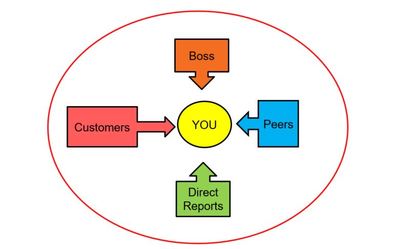|
I recently experienced a “gold nugget” moment in education; that is, one of those moments where a single question or piece of information can change the course of a discussion and lead to important learning.
My college was hosting a small group of business club students from a local high school. There was a scheduling snafu, and the students’ scheduled team-building activity was canceled. I happened to be in the office and had an unscheduled hour, so I hurriedly pulled together some supplies and formulated a plan. I asked the students to draw a picture of “what leadership means to me” on a small dry erase board. Being students after my own heart (and artistic ability), most of them drew stick figures. More specifically, most of them drew some version of a big stick figure telling little stick figures what to do or, for the more enlightened students, a big stick figure working alongside the little stick figures. We discussed the implications of these pictures for a few minutes, and then I asked this question: “Yesterday, how many of you participated in the student walk out about gun violence?” About ⅓ of the students raised their hands. I asked a few students to tell us about what happened, and they recounted a short time of remembrance couple with respectful activism. I then asked this question: “And who was the big stick figure who organized all of this activity?” Silence. Finally, one student spoke up, “There wasn’t a single person. Instead, it was multiple students sharing ideas and organizing. No teachers or staff were even involved.” We then talked about how, in this particular instance, leadership was clearly present and effective, but spread among many people as they shared responsibility and influence. Sure, there are times when a big stick figure is important and effective, but not always. Thus, by finding a clear recent example of shared leadership, the students were able to broaden their perspective about the very nature of leadership. In this case, one salient counterexample to their previous understanding of leadership helped to drive learning. This incident caused me to ponder: what are my own deeply held beliefs about leadership, and can I think of a clear counterexample to them? What about you?
1 Comment
One of the most effective ways to drive to performance is to build self-efficacy, or the fundamental belief that oneself is capable to performing a particular task. But how can we build self-efficacy in ourselves and in others? Research on self-efficacy shows us that one of the best ways to do is is through enactive mastery.
Enactive mastery involves creating a situation in which people can experience a “small win” which becomes a catalyst for further performance. For example, on the very first day of my ninth-grade Latin 1 class, our teacher, Mr. Tuscano, wrote the following sentence on the board, and challenged the class to translate it: “Roma in Italia est.” It didn’t take a Latin expert to figure out that Rome is in Italy. So within the first two minutes of class, we had already translated an entire sentence! This exercise was the very definition of a small win and became a touchstone for the more difficult learning ahead. As another example, my two youngest children have recently begun taking skiing lessons. I’ve noticed that one of the primary goals is to quickly get the kids into a position where they can turn and stop. With commands like “pizza!” and “cookie!”, the kids are able to ski the bunny slope by the end of their first lesson. Their burgeoning confidence leads to enjoyment and motivation to continue to improve. (And, trust me, any experience that leads to a 4-year-old wanting to put the skis on again is a win!) So, as you are thinking about how to build your own self-efficacy, what are some ways you can set yourself for some small wins in order to achieve enactive mastery? Likewise, how can you help others create similar situations? Leadership training and development programs are ubiquitous, They’re also big business as part of a $14 billion industry. Despite the great interest, some companies are asking if it is even worth it?
Ironically, attempts to answer that question come from - wait for it! - the same organizations who provide the training. And the answers are usually some form of, “Not exactly...except for the way we do it!” Fortunately, we can now provide a better answer that is grounded in scientific evidence. A recent meta-analysis published in the Journal of Applied Psychology examined results from 335 studies of leadership training. The results were surprisingly robust, and suggested that leadership training programs can lead to:
The article also suggests some best practices for a successful training program, including:
As a recent seminary graduate entering a PhD program in business, I was shocked - shocked! - to discover that forgiveness in the workplace was a topic of interest to organizational researchers. As one might expect, forgiveness was a common topic among theology scholars. But forgiveness was a relatively new topic in the competitive arena of business. We now know that forgiveness is important anytime we are focusing on human relationships - which, of course, includes business.
Here’s what we know about forgiveness in the workplace:
 What is it? Feedback - that oft-stated, oft-misunderstood grail of organizational life - is simply information provided to a person about his/her behavior and the results of that behavior. 360 feedback is a unique type of feedback that is often used for leader development. Basically, the leader is asked a series of questions about his/her behaviors (e.g., setting a vision or encouraging teamwork) and the results of those behaviors (e.g., fostering trust and team performance). Then, people who know the leader well and have observed his/her behaviors answer the same set of questions. These raters typically consist of the leader’s boss, peers, and direct reports, as well as internal and external customers. It is this feedback from all sides that results in a 360 degree “view” of the leader’s actions. Why do we use it? The answer is very simple: Leader self ratings alone tend to be unreliable and sometimes inaccurate “scores” of a leader’s actual behaviors. This is not to say that leader self ratings are devoid of accuracy; to the contrary, in certain situations they can be quite accurate. Likewise, ratings supplied by other people should not be considered the absolute “true scores” of leader effectiveness. The point is that we need both the leader self rating and the ratings of others to get the most accurate view of the leader’s behaviors and effectiveness. How do we use it? The power of 360 feedback manifests in two main ways. First, by comparing his/her self scores to the scores of others, the leader can develop greater self-awareness. Sometimes, the leader can discover a hidden strength be realizing that others see something that the leader may have missed. For example, perhaps the leader does not see herself as engaging others at an individual level. However, her raters report a high level of individual consideration. As she reflects on some recent incidents, she realizes that she has done a pretty good job of relating on an individual basis. This realization gives her greater confidence in these situations. Second, by using benchmarking data, the leader can identify areas for improvement. In other words, the 360 data is best utilized when the leader sets specific goals for improvement. This is one area in which an experienced leadership coach can be helpful. An experienced coach can help the leader to craft clear goals, find resources to help meet those goals, and act as an accountability partner. Concerns about 360 feedback In our research and consulting, we see three common concerns with 360 feedback 1 - Leaders believe that it is a waste of time The answer to this concern is straightforward: it all depends on the leader. If the leader is motivated to learn and grow, he/she will find something useful in the 360 feedback. We have found this to be the case Every Single Time. 2 - Feedback will not be confidential This concern manifests in two forms. First, raters are concerned that their answers will not be confidential. We address this concern by assuring anonymity, with the following caveats: a) if the leader only invites one person to a particular category (e.g., peer), then the leader will likely know who you are [the exception to this scenario is the direct report category, in which at least two raters must participate in order for feedback to show]. Second, the leader is concerned that others will see his/her feedback. To counter this concern, we stress that the data belongs to the leader, and the leader decides who sees what. Even when we conduct a 360 in an organization, one of our rules of engagement is that senior management will only see data in aggregated form. 3 - Feedback will be used for evaluation instead of development We cannot stress this point enough: 360 feedback should only be used for developmental purposes. When used for evaluation, it is too easy for people to “game the system”. Our suggestion is to require participants to identify 2-3 goals based on their 360 feedback, and to have senior management hold them accountable for goal achievement. Have more questions about 360 feedback? Contact us and we will be glad to help I used to think that identity was a Big Thing. Something to be sought through a heroic journey.
Something conferred by a king. Something important, and once taken on, relatively unchangeable. I still believe those things. Sometimes I even think about in stark terms. What if my most important possessions, most important abilities, and most important relationships were taken away from me - what would be left? That remainder represents the fundamental me, my core identity. True enough, and of utmost significance. But the moments that test our true significance and our core identities are rare. What about the other 99.9% of moments in life? Does identity play a role in those times as well? I think that it does. One way to think of one’s overall identity is as a collection of sub-identities. Sub-identities are nothing more than our identities that are relevant to a particular situation or to a role that we enact. For many of us, our collection of sub-identities looks something like this:
As I write these words, my “professor” sub-identity is active, as I seek to convey information and spark thinking. What is really interesting about sub-identities is that we put them on and take them off, sort of like an article of clothing. Sometimes they are thrust upon us, like when a parenting sub-identity becomes instantly active when a child cries out in the night. Other times, we get to choose them, like when we reach out to invite a friend to meet over a cup of coffee, thus activating our friend sub-identity. In her book Liturgy of the Ordinary, Tish Harrison Warren makes a wonderful point about how we put on and take off identities throughout the day. She notes that on most days, we all start with the same basic identity - that of the half-asleep, half-awake person-waking-up persona, complete with tired eyes and bad breath. From there, we begin to add our other identities, putting them on and putting them off throughout the day, until we at last return to another common-to-us-all identity: the drowsy, tired person in need of rest. So what does all of this have to do with leadership? Well, we know at least two things about a leader identity: 1. It is chosen - even if you are in a leadership role you’d rather not have, you can still choose to view yourself as a developing leader, or not. 2. It applies to many areas of life - whereas identities like employee or parent apply to only area of life, “leader” applies to many areas. You can be a leader at work, with your family, with your friends, or in the community. So if you desire to improve as a leader, one of the most effective ways to do so is to put on your leader identity each morning. Doing so will help you pay attention to leadership opportunities and lessons, give you the courage to try new leadership behaviors, and provide you with the wisdom to evaluate what is and is not working. Just remember to brush your teeth, too. |
|
Copyright © 2023







 RSS Feed
RSS Feed
